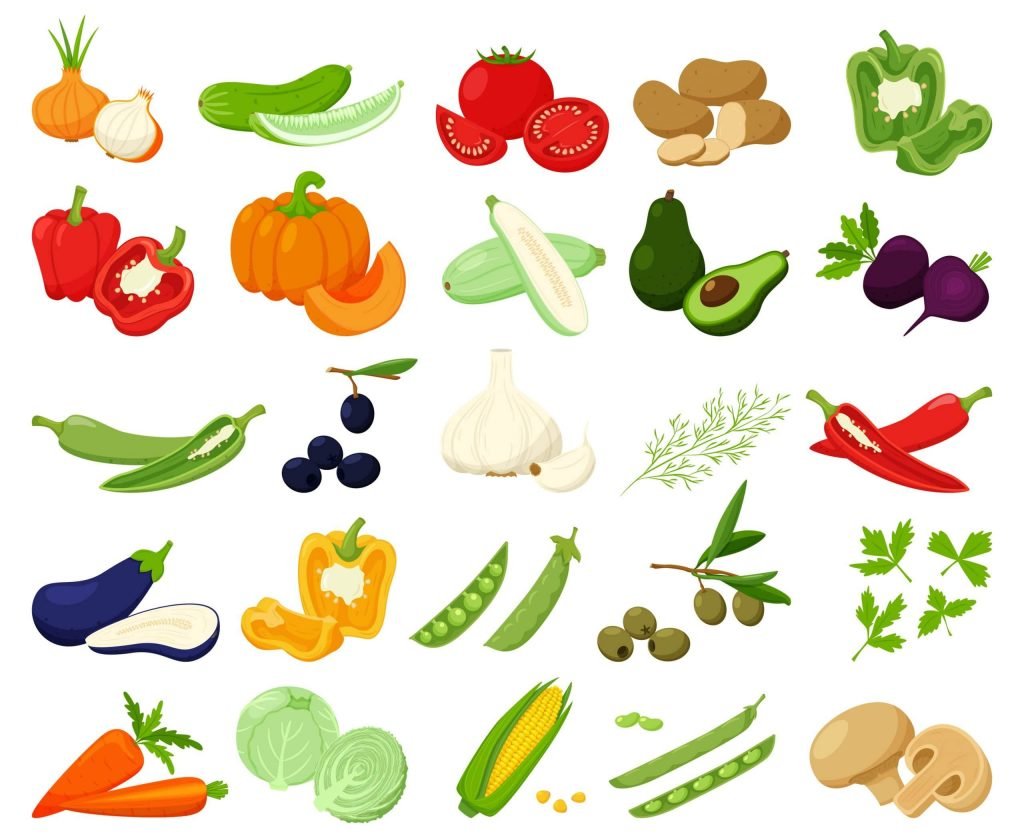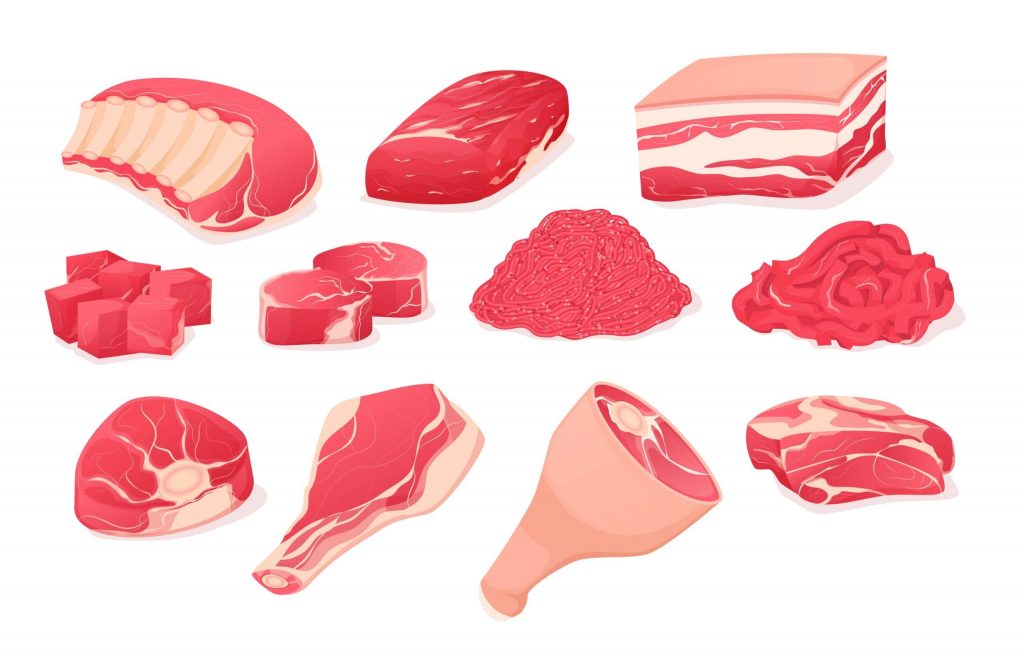Say Beef and Rice in Korean
Korean cuisine is filled with many kinds of delicious foods which makes learning food in Korean crucial. In this lesson, we'll teach you the Korean words for different kinds of food.
The types of food you can find in South Korea are so vast that every experience you have from street food to eating Korean dishes and delicacies in a restaurant is all worthwhile.

In this article, we will be learning the different Korean terms for food – as in what the different vocabulary for different vegetables, fruits, noodles, etc. is. This will be crucial when you are in South Korea especially if you plan to shop for groceries at the supermarket!
Below is a free PDF guide that you can download and take with you:
Let's begin!
Contents
- 1 Food in Korean
- 1.1 Vegetables in Korean
- 1.2 Fruits in Korean
- 1.3 Meat in Korean
- 1.4 Cooking Ingredients in Korean
- 1.5 Beverages in Korean
- 1.6 Types of Food Preparation in Korean
- 2 Describing taste in Korean
Food in Korean
First things first, let's learn the Korean word for food: 음식 (eumsik). It simply means food in general and is the big term you'll want to use when you speak of your country's cuisine.
Another word for food in Korean is 밥 (bap). Now, this word actually means "rice", just like in 비빔밥 (bibimbap) or mixed rice, so you don't want to use it the same way as 음식. However, a common conversation topic of Koreans is asking others whether they've yet eaten, and it's the word 밥 that is typically used in that situation. That is because, in Korean culture, rice is a staple food item in South Korean cuisine. It is found on the table during nearly every meal, including breakfast. In South Korea, when you are thanking for a well-done meal, you'll also use the word 밥.
But now, without further ado, let's get to learning the food vocabulary in Korean!
Vegetables in Korean
These healthy vegetables are essential in Korean cuisine and can be used in different South Korean dishes especially in soup, stew, stir-fried dishes, and noodles.

| Korean | English |
|---|---|
| (yangpa) | Onion |
| (maneul) | Garlic |
| (bomyangpa) | Scallion |
| (danggeun) | Carrot |
| (mu) | Radish |
| (yangbaechu) | (Chinese) Cabbage |
| (sangchu) | Lettuce |
| (gochu) | Red Pepper |
| (pimang) | Bell Pepper |
| (saenggang) | Ginger |
| (insam), (jinsaeng) | Ginseng |
| (beurokolli) | Broccoli |
| (beoseot) | Mushroom |
| (gamja) | Potato |
| (goguma) | Sweet Potato |
| (gaji) | Eggplant |
| (aehobak) | Zucchini |
| (hobak) | Pumpkin |
| (sigeumchi) | Spinach |
| (kongnamul) | Bean Sprouts |
| (yeongeun) | Lotus Root |
| (pa) | Green Onion |
| (tomato) | Tomato |
| (oi) | Cucumber |
| (cheonggyeongchae) | Bok Choy |
| (kkonnyangbaechu) | Cauliflower |
| (wandukong) | Pea |
| (paseulli) | Parsley |
| (biteu) | Beetroot |
| (selleori) | Celery |
| (aseuparageoseu) | Asparagus |
| (kon) | Corn |
| (kong) | Beans |
Cabbage in Korean
Cabbage in Korean is 양배추. This is the main ingredient for the popular Korean side dish called Kimchi. It's made of cabbage and chili powder. However, kimchi isn't limited to cabbage.
Scallion in Korean
The Korean term for scallion is 봄양파 (bomyangpa). This is used alongside seafood to create the famous dish 해물파전 (haemul pajeon) which is a savory pancake. This vegetable is also similar to green onions which translate to 파 (pa) in Korean.
Fruits in Korean
This list shows Korean words for healthy foods that can be enjoyed as is or can be made into something even better.
![]()
| Korean | English |
|---|---|
| (manggo) | Mango |
| (podo) | Grape |
| (boksunga) | Peach |
| (banana) | Banana |
| (orenji) | Orange |
| (hallabong) | Jeju Orange |
| (papaya) | Papaya |
| (sagwa) | Apple |
| (subak) | Watermelon |
| (painaepeul) | Pineapple |
| (mellon) | Melon |
| (gam) | Persimmon |
| (seongnyu) | Pomegranate |
| (ttalgi) | Strawberry |
| (jamong) | Grapefruit |
| (jadu) | Plum |
| (santtalgi) | Raspberry |
| (gyul) | Mandarin, Tangerine |
Banana in Korean
This is very easy to remember as the Korean term for banana is also 바나나 (banana).
For even more vegetable and fruit vocabulary, we have an article solely dedicated to them right here!
Meat in Korean
Meat in Korean is 고기 (gogi). These are used as the main ingredient for plenty of food that Koreans and people all around the globe enjoy.
| Korean | English |
|---|---|
| (soegogi) | Beef |
| (dwaejigogi) | Pork |
| (dalgogi) | Chicken |
| (mulgogi) | Fish |
| (origogi) | Duck |
| (samgyeopsal) | Pork Belly |
| (bulgogi) | Marinated Beef Slices |
| (seuteikeu) | Steak |
| (beikeon) | Bacon |
| (haem) | Ham |
| (dakgalbi) | Chicken Ribs |
| (dubu) | Tofu |
| (gyeran) | Eggs |
| (chijeu) | Cheese |
Marinated Beef Slices in Korean
Marinated beef slices in Korean are called 불고기 (bulgogi). This meat is often served in barbecue places or can also be stir-fried.
Pork Belly in Korean
Pork belly meat in Korean is called 삼겹살 (samgyeopsal). These are pork strips which are also often grilled in Korean barbecue restaurants. You can eat it with rice, lettuce, or side dishes like kimchi. Whichever flavor suits your palate!
For more vocabulary for the different meats and meat dishes, you can check out our article on meat in Korean!
Cooking Ingredients in Korean
Each ingredient on the list helps enhance the flavor of the dish that you plan to make to match your palate.
| Korean | English |
|---|---|
| (bap) | Rice |
| (sogeum) | Salt |
| (huchu) | Black Pepper |
| (sikcho) | Vinegar |
| (ganjang) | Soy Sauce |
| (gireum) | Oil |
| (seoltang) | Sugar |
| (milgaru) | Flour |
| (beoteo) | Butter |
| (kecheop) | Ketchup |
| (mayonejeu) | Mayonnaise |
| (jungjo) | Baking Soda |
| (beikingpaudeo) | Baking Powder |
| (ppang) | Bread |
| (paseuta) | Pasta |
| (kkul) | Honey |
| (hat soseu) | Hot Sauce |
| (sinamon) | Cinnamon |
| (gochutgaru) | Chili Powder |
| (gochujang) | Chili Pepper Paste |
| (haecho) | Seaweed |
| (chamgireum) | Sesame Oil |
Rice in Korean
Rice in Korean is 밥 (bap) and this staple Korean food is an ingredient used in 비빔밥 (bibimbap). This dish means "mixed rice" where rice is mixed in a bowl with different ingredients. This may include vegetables, ground beef, seasoned seaweed, and a spicy sauce made from chili paste, soy sauce, sesame oil, brown sugar. Oftentimes, you can top this with kimchi and fried egg too, depending on your variation!
Soy Sauce in Korean
Soy sauce is an important ingredient that is well-known and is essential in different cuisines around the world. In Korea, soy sauce is called 간장 (ganjang).
Chili Pepper Paste
The chili paste is part of most dishes cooked in South Korea and is called 고추장 (gochujang). A red chili paste gives a dish its flavor and fiery color that is common in cuisines cooked by Koreans especially in soup or stew dishes. You can also find this as a sweet and spicy sauce for 떡볶이 (tteokbokki )which is a traditional Korean dish made of rice cakes (glutinous rice flour) and fish cakes.
Beverages in Korean
Another important vocabulary to learn is what we usually pair with our food which is the beverages.

| Korean | English |
|---|---|
| (mul) | Water |
| (uyu) | Milk |
| (keopi) | Coffee |
| (cha) | Tea |
| (juseu) | Juice |
| (tansaneumnyo) | Soda |
| (kolla) | Coca Cola |
| (maekju) | Beer |
| (soju) | Soju |
| (makgeolli) | Rice Wine |
Soju
This alcoholic beverage is a signature drink enjoyed by Koreans. 소주 (soju) can be paired with anything, from fried chicken to Korean BBQ, to any various street food.
Rice Wine in Korean
Another popular and traditional alcoholic beverage in Korea is the Korean Rice Wine which is called 막걸리 (makgeolli). This is often paired with the savory Korean pancake called (파전) pajeon.
Beer in Korean
This popular drink is the perfect company to cap off the busy week for some. If you're in South Korea and you want to buy one, you can ask for a beer in Korean as 맥주 (maekju).
Get "Food in Korean" Free PDF Guide
Types of Food Preparation in Korean
In this section, we will teach you vocabulary that is based on the method with which a dish in Korea, from meat dishes to soup or stew types of dishes was prepared. These methods of cooking contribute to the variation of Korean dishes. You will usually find these words included in the name of the dish, just like in other languages.

Fried in Korean
The term for fried in Korean is 볶음 (bokkeum). For example 볶음밥 (bokkeumbap), which is fried rice. Another example is 제육볶음 (jeyuk bokkeum) which means stir-fried pork.
Stew in Korean
The word for stew in Korean is 찌개 (jjigae). Traditional Korean food recipes for this type of food have existed for a long time just like the Army Stew or 부대찌개 (budaejjigae) which was made popular after the Korean War. Other popular types of stew in South Korea are 순두부찌개 (sundubu jjigae) or soft tofu stew, and 김치찌개 (kimchi jjigae), which is kimchi stew.
Soup in Korean
For soup in Korean, there are two words. A bowl of these will surely keep you warm.
The first word is 국 (guk), which is a native Korean word and usually attached to dishes that are lighter and have a lot of vegetables, such as 미역국 (miyeokguk), which is seaweed soup.
The second word is 탕 (tang), which is a Sino-Korean word. These soups may be heavier and less watery, for example, 삼계탕 (samgyetang), which is a ginseng chicken soup made with a whole chicken. Another example is 설렁탕 (seolleongtang) also known as ox bone soup which is made from ox bones and other cuts. Boiling this soup for several hours creates a rich beef broth.
Noodles in Korean
There are different noodle dishes and we'll show you three words for noodles in Korean.
The first word is 사리 (sari), which refers specifically to uncooked noodles. The native Korean word for noodles is 국수 (guksu), such as 칼국수 (kalguksu), which stands for handmade chopped noodles. The Sino-Korean word for noodles is 면 (myeon), such as 라면 (ramyeon), which means instant noodles or 냉면 (naengmyeon) which is made of cold buckwheat noodles. Otherwise, there is no big distinction when you use 국수 and 면.
Steamed in Korean
The word for steamed in Korean is 찜 (jjim). For example 찜닭 (jjimdal), which can be translated as both steamed chicken or braised chicken.
Roasted in Korean / Grilled in Korean
Although not exactly the same method of cooking, for both roasted and grilled dishes, we use the word 구이 (gui). For example, 조개구이 (jogaegui), which means roasted clams.
Side Dishes in Korean
As there are a variety of side dishes eaten at every meal in Korea, it is also good to learn the general term for a side dish in Korean, which is 반찬 (banchan). The most common side dish that you can find during meals is 김치 kimchi. There are plenty of other side dishes but some other examples are 해물파전 (haemul pajeon), sweet potatoes, fish cake, and mung bean sprout.
Raw in Korean
Some food in South Korea is also eaten raw, and therefore it's good to know this word as well. The word for it is 회 (hoe). For example, 육회 (yukhoe), which is raw beef.
Describing taste in Korean
We already have a separate article to help you with ordering food in Korea, but we wanted to quickly go over some basic phrases and terms with which you can describe the Korean food you are eating.
| Korean | English |
|---|---|
| (sseun mat) | Bitter taste |
| (maewoyo) | Spicy |
| (dugeowoyo) | Hot |
| (dalkomhaeyo) | Sweet |
| (masisseoyo) | Delicious |
| (mat obseoyo) | Not good |
| (masi pungbuhaeyo) | Rich in flavor |
| (saekomhaeyo), (sikeumhaeyo) | Sour |
| (eumsigi sanghaetda) | It's gone bad |
| (jeubi manayo) | Juicy |
| (jjolgitjjolgithada), (jjondeukjjondeukada), (bolgangbolgang) | Chewy |
Sour in Korean
The word for sour in Korean is 새콤해요 (saekomhaeyo) but you can also say it as 시큼해요 (sikeumhaeyo). You can use this word to describe sour foods like Kimchi, citrus fruits, or vinegar.
Sweet in Korean
Sweet in Korean is 달콤해요 (dalkomhaeyo) which can be used in describing the sweet taste in food like desserts.
Spicy in Korean
There is plenty of Korean food that you can describe with the word for spicy in Korean which is 매워요 (maewoyo). A great example would be Buldak (불닭) or spicy chicken.
Salty in Korean
Sometimes, you might want your food to have more flavor, or you find it a bit too salty. Either way, the word for salty in Korean is 짜요 (jjayo).
Wow, did this post make you massively hungry for Korean food? Because it sure made us! Hopefully, this was educational and will make your next meal in a Korean restaurant, at home, or with street food a more exciting experience. Next up do read our article introducing specific dishes from Korean cuisine!
holstongerfinst96.blogspot.com
Source: https://www.90daykorean.com/food-in-korean/
0 Response to "Say Beef and Rice in Korean"
Postar um comentário